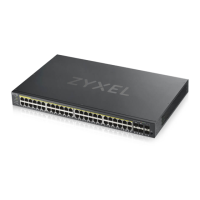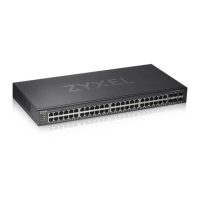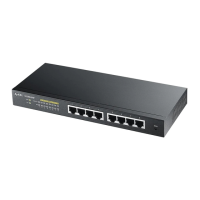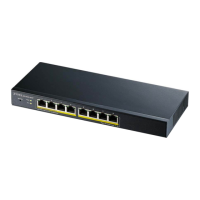
Do you have a question about the ZyXEL Communications GS1920 Series and is the answer not in the manual?
| Brand | ZyXEL Communications |
|---|---|
| Model | GS1920 Series |
| Category | Switch |
| Language | English |
Provides recommendations for regular maintenance to enhance switch security and management.
Explains how to reset the switch to its factory default configuration file.
Details the procedure for accessing the web configurator using a web browser.
Recommends changing the default administrator password upon first login for security.
Explains how to save configuration changes to non-volatile memory for persistence.
Provides instructions for reloading the factory-default configuration file.
Explains how to create VLANs to confine broadcast frames to specific port groups.
Explains how to configure the switch's management IP address in a different subnet.
Guides through configuring DHCPv4 snooping to enhance network security and control.
Explains how to configure the switch to forward DHCP client requests to a specific DHCP server.
Covers configuration of the switch IP address, default gateway, and management VLAN ID.
Details configuring up to 64 IP addresses for switch management access.
Enables viewing IEEE 802.1Q VLAN parameters for the switch.
Guides on configuring a static VLAN for the switch.
Explains how to assign static MAC addresses to a port for controlled access.
Guides on configuring rules to forward specific multicast frames to designated ports.
Explains how to create rules for traffic filtering through the switch.
Guides on configuring RSTP settings for faster convergence.
Explains how to configure MRSTP for multiple spanning trees on a switch.
Guides on configuring MSTP to address limitations of older STP protocols.
Guides on limiting bandwidth for traffic flows on a port.
Guides on limiting broadcast, multicast, and DLF packets per second on ports.
Guides on selecting a monitor port and specifying traffic flow to copy.
Guides on enabling port authentication methods and configuring RADIUS server settings.
Details the steps to activate IEEE 802.1x security on the switch.
Guides on activating MAC authentication for port access.
Guides on enabling port security and disabling MAC address learning.
Guides on defining schedules for time-oriented features.
Guides on defining classifiers and specifying actions for matching traffic.
Guides on configuring policy rules based on defined classifiers.
Details setting priorities for switch queues to distribute bandwidth.
Allows configuration of IGMP for IPv4, MLD for IPv6, and multicast VLANs.
Enables IGMP snooping to forward multicast traffic only to group members.
Guides on configuring RADIUS server settings for authentication.
Guides on configuring TACACS+ server settings for authentication.
Configures authentication, authorization, and accounting settings and database priority.
Shows current bindings for DHCP snooping and ARP inspection.
Displays statistics about the DHCP snooping database.
Enables DHCP snooping and configures the DHCP snooping database.
Enables ARP inspection and configures global settings for the ARP inspection log.
Guides on enabling loop guard on the switch and specific ports.
Guides on enabling layer 2 protocol tunneling and specifying MAC addresses for encapsulation.
Configures the switch to provide subscriber information to PPPoE servers.
Limits control packets (ARP, BPDU, IGMP) received or transmitted on a port.
Configures detection of control packet rate limits and actions upon exceeding them.
Sets the switch to automatically undo actions after errors are resolved.
Guides on setting up port isolation rules for private VLANs.
Guides on configuring Energy Efficient Ethernet (EEE), Auto Power Down, and Short Reach.
Guides on configuring global LLDP settings on the switch.
Guides on configuring LLDP-MED parameters.
Covers configuring and enabling an IPv4 static route.
Guides on activating DiffServ to apply marking rules or IEEE 802.1p priority mapping.
Guides on enabling and configuring DHCPv4 relay and DHCPv6 relay settings.
Explains configuring DHCP relay if clients and server are not in the same broadcast domain.
Configures global DHCPv4 relay settings for the switch.
Guides on upgrading the switch firmware to the latest version.
Explains how to restore a previously saved configuration file to the switch.
Details how to save and store current device settings.
Guides on configuring SNMP settings, versions, and community strings.
Explains how to set up administrator and non-administrator login accounts.
Specifies trusted computers for managing the switch.
Allows pinging IP addresses, running traceroute, and performing port tests.
Allows checking current system logs and understanding recorded messages.
Configures device logging settings and lists external syslog servers.
Guides on configuring cluster management settings.
Allows checking if MAC addresses are dynamic or static.
Allows viewing IP-to-MAC address mappings and removing dynamic ARP entries.
Guides on copying basic and advanced settings from a source port to destination ports.
Provides troubleshooting steps for power, hardware, and LED issues.
Offers solutions for forgotten IP addresses, usernames, or login screen access issues.
Addresses issues related to losing configuration settings after restarting the switch.
Explains DHCPv6 as a server-client protocol for assigning IPv6 network addresses.
Lists critical safety precautions for using the product correctly and avoiding hazards.










